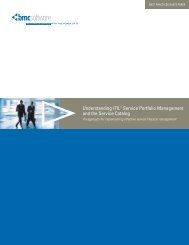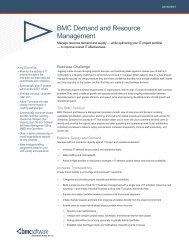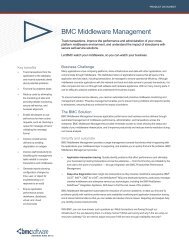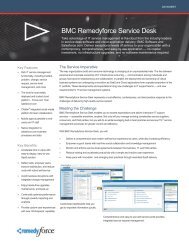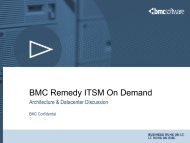- Page 1: Step-by-Step Guide to Building a CM
- Page 5 and 6: ©2008 BMC Software, Inc. All right
- Page 7: STAGE 4 Construct and Maintain Your
- Page 11 and 12: You can identify how the CMDB will
- Page 13 and 14: Brian Emerson — A senior solution
- Page 15 and 16: Additional Contributors Bob Balassi
- Page 17 and 18: Stage 1. Assemble the Project Team
- Page 19 and 20: Stage 1. Assemble the Project Team
- Page 22 and 23: Stage 1. Assemble the Project Team
- Page 24 and 25: Stage 1. Assemble the Project Team
- Page 26 and 27: Stage 1. Assemble the Project Team
- Page 28 and 29: Stage 1. Assemble the Project Team
- Page 30 and 31: Stage 1. Assemble the Project Team
- Page 32 and 33: Stage 1. Assemble the Project Team
- Page 34: Stage 1. Assemble the Project Team
- Page 37 and 38: Step 3 Create and Agree on CMDB Goa
- Page 39 and 40: Step 3. Create and Agree on CMDB Go
- Page 41 and 42: Step 3. Create and Agree on CMDB Go
- Page 43 and 44: Step 4 Review and Define Benefits G
- Page 45 and 46: Step 4. Review and Define Benefits
- Page 47 and 48: Step 4. Review and Define Benefits
- Page 49 and 50: Step 4. Review and Define Benefits
- Page 51 and 52: Step 4. Review and Define Benefits
- Page 53 and 54: Step 5 Build a Business Case Goals
- Page 55 and 56: Step 5. Build a Business Case »»
- Page 57 and 58: Step 5. Build a Business Case For t
- Page 60 and 61:
Step 5. Build a Business Case Task
- Page 62 and 63:
Stage 2. Define Requirements and Cr
- Page 64:
Stage 2. Define Requirements and Cr
- Page 67 and 68:
Step 6 Identify and Review Governan
- Page 69 and 70:
Step 6. Identify and Review Governa
- Page 72 and 73:
Step 6. Identify and Review Governa
- Page 74 and 75:
Stage 2. Define Requirements and Cr
- Page 76 and 77:
Stage 2. Define Requirements and Cr
- Page 78 and 79:
Stage 2. Define Requirements and Cr
- Page 80 and 81:
Stage 2. Define Requirements and Cr
- Page 82:
Stage 2. Define Requirements and Cr
- Page 85 and 86:
Step 9 Identify Inventory and Asset
- Page 87 and 88:
Step 9. Identify Inventory and Asse
- Page 89 and 90:
Step 9. Identify Inventory and Asse
- Page 91 and 92:
Step 10 Define Service Catalog Requ
- Page 93 and 94:
Step 10. Define Service Catalog Req
- Page 95 and 96:
Step 10. Define Service Catalog Req
- Page 98 and 99:
Step 10. Define Service Catalog Req
- Page 100 and 101:
Stage 2. Define Requirements and Cr
- Page 102:
Stage 2. Define Requirements and Cr
- Page 105 and 106:
Step 12 Define Configuration Item L
- Page 107 and 108:
Step 12. Define Configuration Item
- Page 109 and 110:
Step 12. Define Configuration Item
- Page 111 and 112:
Step 12. Define Configuration Item
- Page 113 and 114:
Step 12. Define Configuration Item
- Page 115 and 116:
Step 12. Define Configuration Item
- Page 117 and 118:
Step 13 Define Configuration Item R
- Page 119 and 120:
Step 13. Define Configuration Item
- Page 121 and 122:
Step 13. Define Configuration Item
- Page 123 and 124:
Step 13. Define Configuration Item
- Page 125 and 126:
Step 14 Define Configuration Item A
- Page 127 and 128:
Step 14. Define Configuration Item
- Page 129 and 130:
Step 14. Define Configuration Item
- Page 131 and 132:
Step 14. Define Configuration Item
- Page 134 and 135:
Step 14. Define Configuration Item
- Page 136 and 137:
Stage 2. Define Requirements and Cr
- Page 138 and 139:
Stage 2. Define Requirements and Cr
- Page 140 and 141:
Stage 2. Define Requirements and Cr
- Page 142 and 143:
Stage 2. Define Requirements and Cr
- Page 144:
Stage 3. Select CMDB Solution and T
- Page 147 and 148:
Step 16 Select CMDB Solution Goals
- Page 149 and 150:
Step 16. Select CMDB Solution Follo
- Page 151 and 152:
Step 16. Select CMDB Solution You c
- Page 153 and 154:
Step 16. Select CMDB Solution Figur
- Page 155 and 156:
Step 16. Select CMDB Solution a gap
- Page 157 and 158:
Step 16. Select CMDB Solution Figur
- Page 160 and 161:
Step 16. Select CMDB Solution If th
- Page 162 and 163:
Stage 3. Select CMDB Solution and T
- Page 164 and 165:
Stage 3. Select CMDB Solution and T
- Page 166 and 167:
Stage 3. Select CMDB Solution and T
- Page 168 and 169:
Stage 3. Select CMDB Solution and T
- Page 170 and 171:
Stage 3. Select CMDB Solution and T
- Page 172 and 173:
Stage 3. Select CMDB Solution and T
- Page 174 and 175:
Stage 3. Select CMDB Solution and T
- Page 176 and 177:
Stage 3. Select CMDB Solution and T
- Page 178 and 179:
Stage 3. Select CMDB Solution and T
- Page 180 and 181:
Stage 3. Select CMDB Solution and T
- Page 182 and 183:
Stage 3. Select CMDB Solution and T
- Page 184 and 185:
Stage 3. Select CMDB Solution and T
- Page 186:
Stage 3. Select CMDB Solution and T
- Page 189 and 190:
Construct and Maintain Your CMDB ST
- Page 191 and 192:
You may want to use the following a
- Page 193 and 194:
Step 20 Construct Your CMDB Goals a
- Page 195 and 196:
Step 20. Construct Your CMDB Scenar
- Page 197 and 198:
Step 20. Construct Your CMDB The Fe
- Page 200 and 201:
Step 20. Construct Your CMDB it let
- Page 202 and 203:
Stage 4. Construct and Maintain You
- Page 204 and 205:
Stage 4. Construct and Maintain You
- Page 206 and 207:
Stage 4. Construct and Maintain You
- Page 208 and 209:
Stage 4. Construct and Maintain You
- Page 210 and 211:
Stage 4. Construct and Maintain You
- Page 212 and 213:
Stage 4. Construct and Maintain You
- Page 214:
Stage 4. Construct and Maintain You
- Page 217 and 218:
Step 23 Populate Your CMDB Goals an
- Page 219 and 220:
Step 23. Populate Your CMDB regular
- Page 221 and 222:
Step 23. Populate Your CMDB »» Th
- Page 223 and 224:
Step 23. Populate Your CMDB As you
- Page 225 and 226:
Step 24 Train the CMDB Team and Use
- Page 227 and 228:
Step 24. Train the CMDB Team and Us
- Page 229 and 230:
Step 24. Train the CMDB Team and Us
- Page 232 and 233:
Step 24. Train the CMDB Team and Us
- Page 234:
Stage 5. Driving Ongoing Value Duri
- Page 237 and 238:
Step 25 Implement Measures and Metr
- Page 239 and 240:
Step 25. Implement Measures and Met
- Page 241 and 242:
Step 25. Implement Measures and Met
- Page 243 and 244:
Step 25. Implement Measures and Met
- Page 245 and 246:
Step 26 Create a Continual Service
- Page 247 and 248:
Step 26. Create a Continual Service
- Page 249 and 250:
Step 26. Create a Continual Service
- Page 251 and 252:
Step 26. Create a Continual Service
- Page 253:
Step-by-Step Guide to Building a CM





